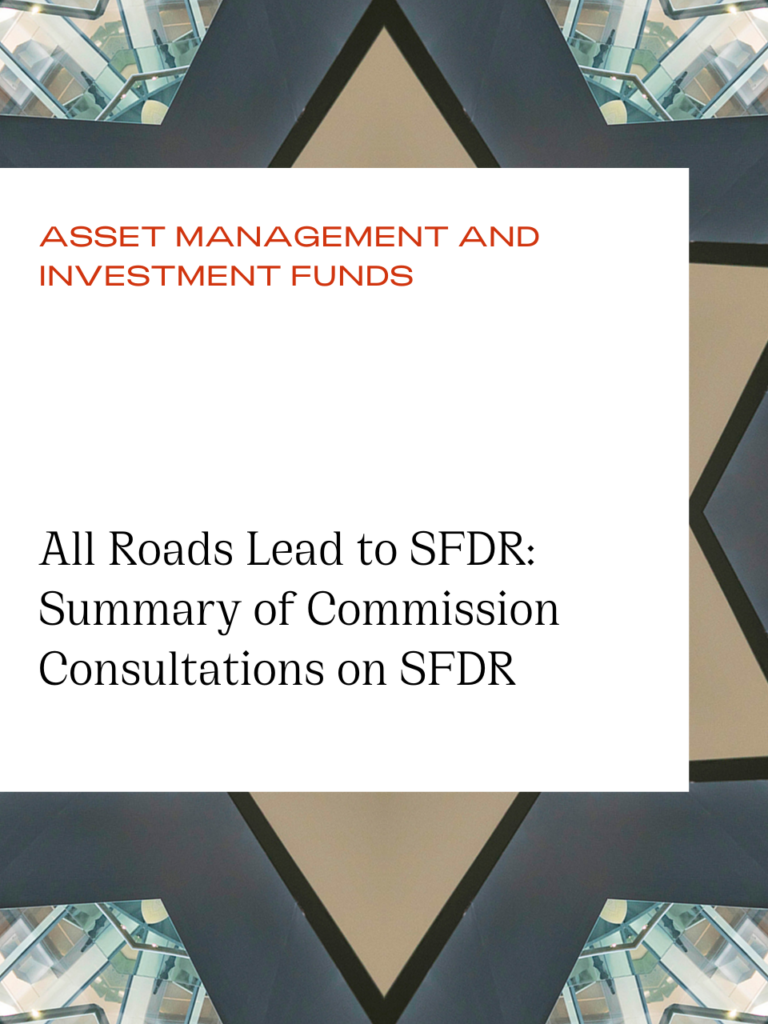
All Roads Lead to SFDR: Summary of Commission Consultations on SFDR
On 14 September 2023, the European Commission launched two consultations on the Sustainable Finance Disclosures Regulation (SFDR): a public consultation (the Public Consultation) and a targeted consultation (the Targeted Consultation, and together with the Public Consultation, the Consultations). Both Consultations will close on 15 December 2023 and the European Commission plans to publish a feedback report in Q2 2024.
The purpose of the Consultations is to provide feedback to the European Commission on any shortcomings in the SFDR framework and options for improving the regime. We published an overview of the Consultations in our Insights Blog previously and the purpose of this bulletin is to provide more detail on the content of the Consultations.
The themes covered in the Consultations indicate that the European Commission is aware of some fundamental concerns regarding SFDR and acknowledges that SFDR would benefit from further clarity. These themes include:
- whether SFDR is meeting its objectives or whether the regime is being used as a labelling and marketing tool;
- the extent to which the industry is facing data gaps or issues with data quality;
- whether the costs incurred by the financial services industry are proportionate to the benefits for investors;
- whether the disclosure requirements should be harmonised across all products;
- how product-level disclosures could be improved and streamlined; and
- whether Article 8 and 9 classifications should be maintained and/or what additional categorisations should be created.
While the opportunity to provide feedback to the Commission is very welcome, those considering responding to the Public Consultation or Targeted Consultation should be aware that some of the questions seek highly detailed responses (for example, questions relating to costs incurred from complying with SFDR disclosure requirements require disclosure of such costs as a percentage of total assets managed).
Public Consultation
The Public Consultation is made up of two sections. Section 1 focuses on the current requirements of SFDR and seeks feedback on how SFDR is operating in practice. The relevant questions from Section 1 can be summarised as follows:
Section 1
| Is SFDR meeting its objectives to: (i) increase transparency in respect of each of the sustainability-related disclosures; (ii) protect investors and enable them to compare financial products; (iii) channel capital towards sustainable investments; (iv) integrate ESG considerations into the investment and advisory process in a consistent manner; and (v) integrate remuneration policies with sustainability risks and long-term sustainable growth? |
| Are EU-level disclosure requirements more effective and efficient than national-level requirements? |
| Has there been a change to investment decisions and the design of funds since the introduction of sustainability risk and adverse impact disclosure requirements at entity and product level under SFDR? |
| Are SFDR disclosures useful to investors, and are the legal requirements and concepts sufficiently clear? |
| Is SFDR being used as a labelling and marketing tool rather than as a disclosure framework? |
| Are stakeholders facing data gaps or issues with data quality? |
| Are investments in transition assets captured effectively and is shareholder engagement adequately supported? |
| Are there any other deficiencies with SFDR rules? Do any of the above issues create legal uncertainty / reputational risks / risks of greenwashing and mis-selling / risks that capital is not being allocated to sustainable investments effectively? |
| In the context of the principal adverse impact (PAI) requirements that apply at entity level, should the indicators in Tables 2 and 3 of Annex I of SFDR be mandatory or should the indicators in Table 1 should be subject to a materiality assessment? Should there be any changes to the indicators in Table 1? |
| In the context of the do-no-significant-harm assessment, are there any issues with the requirement to “take account” of the PAI indicators of Annex I of SFDR? |
| Are the costs of disclosure proportionate to the benefits, and what levels of one-off and recurring disclosure compliance costs are stakeholders experiencing? This question asks respondents to provide estimates of: (i) one-off and recurring annual costs, broken down into sub-categories that separate internal and external costs; (ii) costs split between product-level and entity-level disclosures; (iii) how many full-time-equivalent employees are involved in preparing SFDR disclosures; and (iv) percentage costs of retrieving, analysing, and reporting on SFDR disclosures. |
| Is SFDR sufficiently flexible in allowing the use of estimates, and what are the sources of such estimates? Does the respondent engage with investee companies to encourage reporting of missing data? |
| Has the respondent increased its offer of sustainability products since the introduction of SFDR? If so, what were the factors that influenced the increase? |
Section 2 looks for feedback on the interplay between SFDR and other existing sustainable finance legislation (i.e. the Taxonomy Regulation, the Corporate Sustainability Reporting Directive, the Benchmarks Regulation, MiFID II, the Insurance Distribution Directive and the PRIIPs Regulation). Among other questions, it asks whether differences between the definitions used in each piece of legislation create practical challenges.
Targeted Consultation
The Targeted Consultation is aimed at regulators, public bodies, financial market participants, investors, and NGOs with an in-depth knowledge of SFDR. As part of the targeted consultation, the Commission notes that the “SFDR was designed as a disclosure regime, but is being used as a labelling system, suggesting that there might be a demand for establishing sustainability product categories.” The Targeted Consultation is made up of four sections.
Section 1 and Section 2 are identical to those in the Public Consultation.
Section 3 seeks feedback on the usefulness of entity-level disclosures and whether they could be streamlined. The relevant questions from Section 3 can be summarised as follows:
Section 3
| Are the entity-level disclosure requirements in Article 3 (website disclosure requirements), Article 4 (PAI) and Article 5 (remuneration policy) under SFDR useful? |
| Of the PAI indicators set out in Tables 1, 2 and 3 of Annex I of SFDR, which are the most and least useful? |
| For entity-level disclosures, is SFDR the right place for such disclosures or could this be streamlined across other legislation, such as the Corporate Sustainability Reporting Directive or the Capital Requirements Regulation? |
| For fund-level disclosures, should there be uniform disclosure requirements for all funds, regardless of their sustainability-related claims or otherwise? If so, should the following disclosures be mandatory for all funds: (i) PAI; (ii) taxonomy; (iii) engagement strategies; (iv) exclusions; (v) how ESG-related information is used in the investment process. Are there other disclosure requirements that the respondent can suggest? |
| Alternatively, should there be a criteria / threshold over which such uniform disclosure requirements should apply? If so, what would this be and should a limited number of PAI indicators be mandatory? |
| In general, is it appropriate to have fund-level disclosures in three places, i.e. pre-contractual, financial statements, and website? Is the current breakdown of information between these places user friendly? |
| Is it useful that the fund-level website disclosures are publicly available? Are there any confidentiality issues? Should public disclosure requirements instead be left to other legislation, such as UCITS or AIFMD? |
| Should fund-level disclosure requirements be independent from, or conditional on, entity-level disclosure requirements? |
| Should there be a visual scale for fund-level disclosures such as, for example, disclosures similar to the SRRI scale for UCITS KIIDs? If so, what information would be expressed on this? |
| In practice, do professional investors obtain sustainability information by asking fund managers directly, or from reviewing SFDR disclosures? Do professional investors find the SFDR requirements have improved the quality and transparency of sustainability information? |
| Would it be useful if all SFDR disclosures were required to be machine-readable? Would the costs of this be proportionate to the benefits? |
| Should disclosure obligations be different depending on the underlying investments of the fund such as, for example, where investments are made outside the EU, in emerging markets or in certain sector? |
The focus of Section 3 is on improving the comparability of products for the benefit of investors. There is also an implicit acknowledgment that products which have a greater focus on sustainable investment are unfairly saddled with a higher degree of disclosure and reporting requirements. This indicates a potential move towards harmonising disclosure requirements across all products with a view to creating a more level playing field for funds that focus on sustainable investments.
Section 4 looks at the potential creation of a more precise categorisation system for financial products, against a backdrop of “persistent concerns that the current market use of SFDR as a labelling scheme might lead to risks of greenwashing”. The relevant questions from Section 4 can be summarised as follows:
Section 4
| Would more specific sustainability product categories: (i) facilitate investor understanding; (ii) combat greenwashing; or (iii) assist harmonisation of requirements across EU member states? Are the current disclosure requirements sufficient and more specific categories would be unnecessary? |
| If new sustainability categories were established, should they replace the current Article 8 and 9 classifications by, for example, focusing on the investment strategy of the fund? Or should the existing Article 8 and 9 SFDR classifications be kept, and additional criteria added? |
| If new product categories were established, would the following categories be appropriate: (i) funds investing in assets that specifically strive to offer targeted, measurable solutions to specific sustainability-related problems; (ii) funds that aim to meet credible sustainability standards or adhering to a specific sustainability-related theme; (iii) funds with a transition focus that apply exclusion lists; and (iv) funds aiming to improve the assets they invest in? Are there any other categorisations that the respondent can suggest? What would be the minimum criteria for each? |
| If new categories were established, how many categories should there be in total? Is there merit in distinguishing between social and environmental categories? Should categories be mutually exclusive so that funds may classify as one category only? |
| If new sustainability categories were established, what would be useful to support the transition to these new categories? |
| If the existing Article 8 and 9 SFDR classifications were kept, should the following concepts also be kept: (i) environmental and/or social characteristics; (ii) sustainable investments; (iii) contribution to an environmental or social objective; (iv) do no significant harm, and its link to the PAI indicators; and (v) good governance practices? |
| If the existing Article 8 SFDR classification was kept, how should the meaning of “promotion of environmental and/or social characteristics” be clarified, and what minimum criteria, trigger or threshold should be required? |
| If the existing Article 8 and 9 SFDR classifications were kept, should good governance be adapted to include government bonds and investment in real estate? |
| If the existing Article 8 and 9 SFDR classifications were kept, should Article 8 or 9 SFDR funds be required to have a minimum proportion of investments that comply with taxonomy aligned activities, and what would this be? Should there be any other criterion for a fund to be classified as an Article 8 or 9 SFDR Fund? |
| In addition to the above criteria, should there be any other disclosure requirements when a product falls within a specific sustainability product category? In addition, should the following disclosures be mandatory: (i) taxonomy; (ii) engagement strategies; (iii) exclusions; and (iv) how ESG-related information is used in the investment process? Are there any other disclosure requirements that the respondent can suggest? |
| What governance system should be created? Should third party verification be mandatory, or should stakeholders be able to rely on a self-declaration by a regulated product manufacturer? Should any other criteria be considered, such as underlying investments that are outside the EU, in emerging markets, in certain economic activities, etc? |
| Should the PRIIPs KID disclose the fund’s categorisation under SFDR? |
| If new ESG benchmarks were developed at EU level, should the criteria for the benchmark be closely aligned with product categories? Any other suggestions? |
| Should funds that passively track Paris-aligned benchmarks and climate transition benchmarks be automatically deemed to satisfy a sustainability product category? |
| Should the suitability preferences under MiFID 2 refer to the SFDR categories? |
| Is SFDR the appropriate legal instrument to deal with the accuracy and fairness of marketing communications and the use of sustainability related names for funds? |
| Should product categories have specific rules on labelling and for communicating a fund? Should certain names and terms be restricted to specific categories? |
| Would the creation of naming and marketing communication rules be sufficient to avoid misleading communications from funds that do not come within a product sustainability category? |
This section of the consultation seems to recognise that the original intention for SFDR to be a disclosure regulation has not been entirely successful, on the basis that SFDR has become a product labelling regime with a significant risk of greenwashing. The broad scope for respondents to propose a wide variety of solutions to replace, or add to, the existing Article 8 and 9 classifications under SFDR implies that SFDR may move towards being more of a product regulation. Initial feedback on the Consultations from industry and regulators indicates that the preferred approach will be to maintain and enhance the Article 8 and 9 classifications by the introduction of sub-categories or a scale to assist investors to understand more clearly the difference between products focused on sustainable investments. However, the ultimate direction of travel will be clearer once the Commission publishes its report on the Consultations in 2024.
What’s next?
Both Consultations close for responses on 15 December 2023 and the Commission plans to publish a report on SFDR in Q2 2024.
To discuss any aspect of the Consultations further, please get in touch with your usual Arthur Cox contact, or a member of our multi-disciplinary ESG Group.



